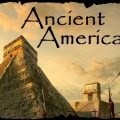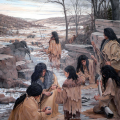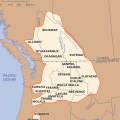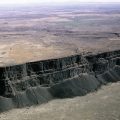
Although the region of North America known today as Wyoming first entered into the written Euro-American histories in the early nineteenth century with the exploits of fur traders, trappers, and non-Indian adventurers, Indian people had been living in the area for many millennia. Archaeologists often refer to the era prior to 6000 BCE as Paleo-Indian. This appears to have been a time when the people specialized in the hunting of big game.
Yellowstone National Park:
While Indian people had utilized the resources and unique geological features of what is now Yellowstone National Park for thousands of years, when the fur traders first began describing the region to non-Indians, they were met with disbelief.
By 9600 BCE, Indian people were camping at Osprey Beach on Yellowstone Lake in present-day Yellowstone National Park.
By 8000 BCE, Indian people were living along the shores of Yellowstone Lake in present-day Yellowstone National Park. The stone tools which they were using resemble those of the complex which archaeologists call Cody (see below).
By 7400 BCE, Indian people using Cody Complex tools at the Osprey Beach site in present-day Yellowstone National Park were hunting a variety of game, including bear, deer, bighorn sheep, bison, and rabbit. They may have been exploiting the resources of Yellowstone Lake using boats.
Hell Gap:
By 9450 BCE, Indian people were beginning to occupy the Hell Gap site (48GO305) in southeastern Wyoming. They were making large, wide, un-stemmed, and lanceolate points with a long, slender tip and a wide, concave base. In his entry on Hell Gape in A Dictionary of Archaeology, William Billeck writes:
“The Hell Gap site consists of a stratified series of short-term campsites where bison was the predominant animal represented.”
By 7600 BCE, the cultural tradition which archaeologists call the Hell Gap Complex moved into the Northern Plains. Hell Gap people were big game hunters with a primary emphasis on bison. In some areas, Hell Gap is associated with bison procurement using a parabolic dune entrapment method.
Clovis:
Clovis culture, which is actually a stone tool technology complex, is one of the earliest well-documented archaeological cultures in North America. The signature artifact of the Clovis people is an atlatl point. The Clovis point is a finely made stone projective point with a characteristic flute which helps in attaching the point to an atlatl dart. Clovis points have lateral indentations (or flutes) which allow them to be efficiently tied to a shaft. The shafts were thrown with the aid of a throwing stick or atlatl. Archaeologists Dennis Stanford and Bruce Bradley, in their book Across Atlantic Ice: The Origins of America’s Clovis Culture, report:
“Fluted projectile points are the most readily identifiable Clovis artifacts, but there are many other items that make up the Clovis inventory. Among these are tools made from blades and flakes struck from specialized cores, plus bi-facially flaked knives and adzes.”
With regard to Clovis in Wyoming, in 9330 BCE, Clovis hunters drove a mammoth into the muck of a bog where it became trapped. They killed it and butchered it, taking the meat to their hunting camp on higher ground.
By 9280 BCE, Clovis people were occupying the Union Pacific site.
By 9250 BCE, Clovis people were occupying the Colby site. The people stacked mammoth bones in what may have been a meat cache. The stone chopper which was used at the site had been made from granite which was not from the area.
By 9200 BCE, Clovis people were camping at the Sheaman site.
Folsom:
About 11,000 years ago, the climate changed: it became warmer (by about 13 degrees Fahrenheit) and drier. There was also an increase in the seasonal extremes: summers were warmer and winters were colder. For Indian people, this difference meant that their cultures had to change so that they could adapt to the new environment.
Folsom people are known for their fluted spear points which were smaller and more delicate than the Clovis points. Their flutes are also longer than Clovis. In his book Bones, Boats, and Bison: Archeology and the First Colonization of Western North America, Archaeologist James Dixon writes:
“The hallmark of Folsom culture is the Folsom projectile point, which is recognized throughout the Americas for its unique design, exceptional workmanship, and the high-quality raw materials from which they are manufactured.”
Geographically, Folsom culture spread eastward from the Rocky Mountains across the Great Plains. It extended from North Dakota to Mexico. It seems to have been centered, however, along the eastern slopes of the Rocky Mountains.
With regard to Wyoming, by 8830 BCE, Folsom hunters were camping on the floodplain of an arroyo in Agate Basin. They trapped, killed and butchered eight buffalo. They lived in hide-covered structures which used bison ribs as tent pegs.
By 8750 BCE, Folsom people were occupying the Hanson site in the northern Bighorn Basin. The people were living in circular structures. The floors of the lodges were covered with a layer of sand. In his book Prehistoric Hunters of the High Plains, George Frison reports:
“The site was apparently a campsite and suggests that many of the usual campsite activities were going on. The most obvious activity was flint knapping and the site provides evidence—from core reduction to tools and finished projectile points—of all the basic processes.”
Frison also reports:
“Projectile point manufacture involved bi-face reduction to a final stage characterized by a blunt, ground distal end and a concave base with a carefully prepared striking platform for channel flake removal.”
Careful striking would then remove the long flake and provide the point with the characteristic Folsom groove. Archaeologists have found evidence of many failures in the final production of Folsom points at this site.
In 7950 BCE, Indian people who were using Folsom tools are occupying the Rattlesnake Pass site (48CR4520).
Cody Complex:
The Cody complex is found in the Northern Great Plains area. In his entry on the Cody Complex in A Dictionary of Archaeology, William Billeck writes:
“The tool assemblage consists of projectile points, flake tools, scrapers, gravers, wedges, choppers, bi-faces, hammer stones, and bone tools that are often found in bison kill and processing sites.”
By 8500 BCE, Indian people from the Cody Complex were spending the warmer months in the Rocky Mountains. Here they repaired and manufactured tools which were used for hunting and for cleaning hides. In the winter, they moved to lower elevations. They were hunting bear, bighorn sheep, deer, and rabbit. According to anthropologist Carroll Riley, in Rio del Norte: People of the Upper Rio Grande From Earliest Times to the Pueblo Revolt:
“Cody stone technology suggests more diverse hunting of a variety of small game.”
By 7076 BCE, Indian people using Cody complex tools were using the Horner site. This was a buffalo kill site or a butchering area. The bison were killed in the fall using a corral at the river’s edge.
Agate Basin:
By 8480 BCE, Indian people were using the Agate Basin site for buffalo hunting. Bison in groups of 10 to 20 animals were apparently driven into the arroyo bottom. The hunters would be stationed at strategic points above the animals in order to harvest them.
By 8000 BCE, the cultural complex which archaeologists call Agate Basin extended into the Northern Plains region. These Agate Basin people were big game hunters whose subsistence strategies included bison trapping. The Agate Basin points were long, narrow, unfluted lanceolate forms. The quality of the lithic work was very good. Archaeologist Sandra Morris, in her University of Montana M.A. Professional Paper Prehistoric Cultural Resources of the Whitetail Pipestone Area, Jefferson County, Montana: An Overview and Implications for Cultural Resource Managers, reports:
“The Agate Basin projectile point morphology is distinct: the form is a long and narrow leaf shape, with no notches.”
Agate Basin appears to be a continuation of Goshen and Folsom in which bison is the economic mainstay.
By 8000 BCE, Indian people at the Agate Basin site had a dog-wolf hybrid.
Two Moon Shelter:
By 8060 BCE, Indian people were using the Two Moon Shelter (48BH1827) in the Bighorn Mountains. In an article in Mammoth Trumpet, Floyd Largent explains:
“A rockshelter is basically a rocky overhang that lacks an extensive interior cave system.”
The Two Moon rockshelter has a protected interior of about 45 square meters with another 30 square meters of flat area just outside of the dripline.
Medicine Creek Lodge Site:
By 7500 BCE, Indian people are now occupying the Medicine Lodge Creek site (48BH499) on the western flanks of the Bighorn Mountains. The site is located at an elevation of 4,800 feet. Indian people at the Medicine Creek Lodge site were hunting small mammals -–mostly bushy-tail wood rats commonly known as packrats (Neotoma cineria). They were also hunting some deer, mountain sheep, and buffalo. They were also using grinding stones to process gathered plant foods.
By 7360 BCE, the people at the Medicine Creek Lodge site were using a Cody Complex tool tradition (see above).
Mummy Cave:
By 7280 BCE, Indian people had begun to live in Mummy Cave (48PA201), a west-facing natural room. This site is located in northwest Wyoming. They were using a side-notched projectile point. Archaeologist Douglas MacDonald, in his book Montana Before History: 11,000 Years of Hunter-Gatherers in the Rockies and Plains, writes:
“Hunters of bighorn sheep utilized the cave during the entire span of its use.”
Nets may have been used to trap the sheep.
Sheep Mountain:
By 7000 BCE, at Sheep Mountain in the Absaroka range Indian people were using nets to harvest game, including mountain goats, deer, and rabbit. They were using a net that was 200 feet long and 6 feet high made from two-ply cord twisted from juniper bark fibers. In his book The Smithsonian Book of North American Indians: Before the Coming of the Europeans, Philip Kopper reports:
“The hunters who made the Sheep Mountain net probably used it by stringing it across a game trail in the rugged mountains and waiting for animals to pass, or by hanging it across a natural bottleneck and driving game into it.”
Granite Creek Rockshelter:
By 6000 BCE, Indian people were using the Granite Creek rockshelter (48BH330) in the Bighorn Mountains. The rockshelter is 85 feet long and 18 feet deep at its deepest point. This was an animal processing area which was used repeatedly by hunting groups for several thousand years. Most of the stone tools at this site were made from local materials.
Note: the information in parenthesis following the name of the site is the Smithsonian Designation System. In this system of recording archaeological sites, the first number refers to the state; this is followed by letters which refer to the county; and then a number indicating its order in being recorded. Thus 5LP 10, means that the site is in Colorado (5th state when the states are listed alphabetically), La Plata County (LP), and was the 10th site recorded in La Plata county in the State Archaeologist’s office.




Leave a Reply